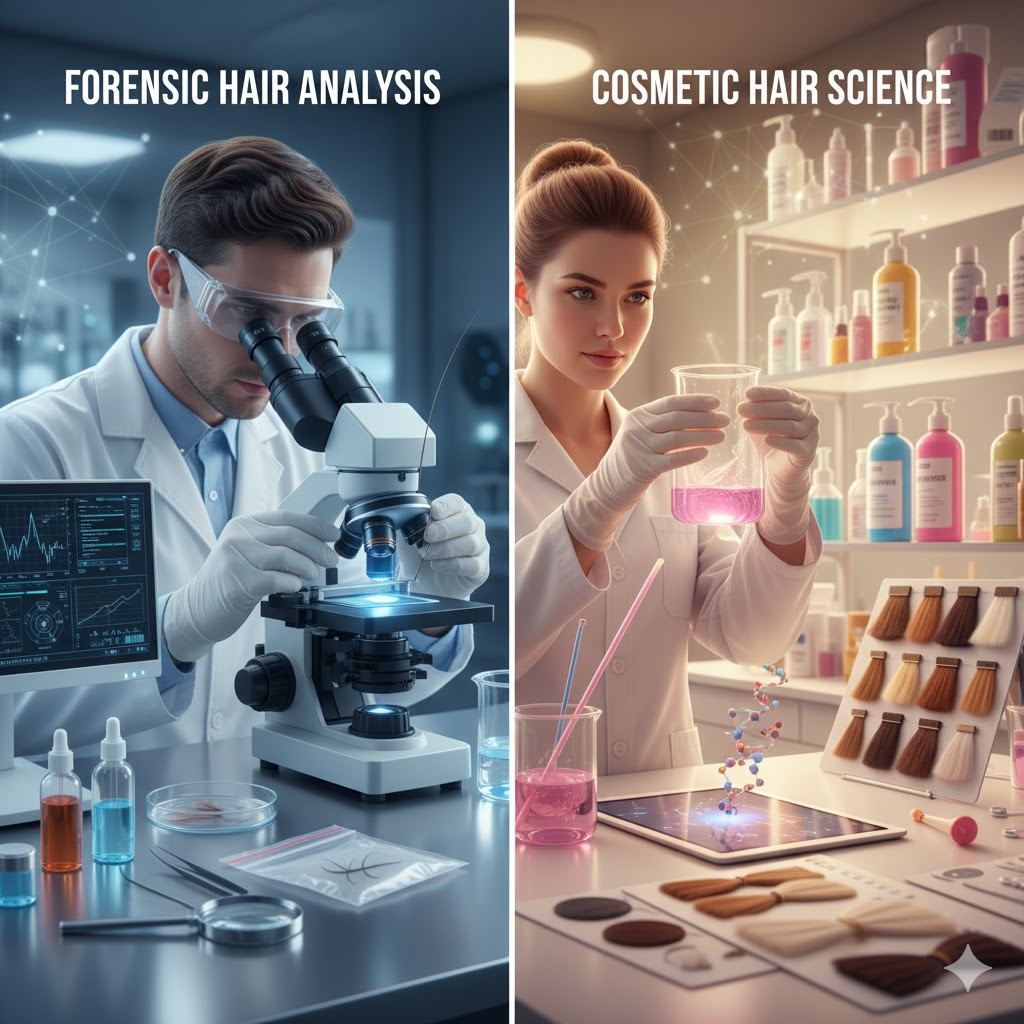Hair has long been a window into our biology. From courtrooms to cosmetic clinics, the study of hair tells a story—whether it’s solving crimes or restoring confidence. But these two fields—forensic hair analysis and cosmetic hair science—rarely intersect in public discussion. That’s starting to change.
At ZMD Hair, we believe in understanding hair not just from the outside in, but also from the inside out. In this blog, we explore how the principles of forensic science and cosmetic hair research are surprisingly aligned—and how bridging these disciplines may unlock better diagnostics, deeper insight into hair health, and more personalized restoration treatments.
What Is Forensic Hair Analysis?
Forensic hair analysis involves the examination of hair fibers to extract information about a person’s identity, habits, or environment. In criminal investigations, forensic scientists analyze hair for:
- DNA traces (if the root is attached)
- Drug metabolites and toxins
- Chemical composition
- Cuticle patterns and medulla shape
- Environmental exposure (e.g., smoke, heavy metals)
Even without DNA, forensic experts can often determine race, diet, drug use, and long-term exposure to chemicals—all through microscopic inspection and chemical testing.
This data helps build a biological timeline, capturing snapshots of a person’s lifestyle and physiology. But the science doesn’t stop at the crime lab.
What Is Cosmetic Hair Science?
Cosmetic hair science focuses on hair health, growth, and restoration. It encompasses:
- Scalp biology
- Follicle function
- Hair shaft structure
- Hormonal influences
- Cosmetic treatments (e.g., dyes, keratin, serums)
- Hair loss conditions (e.g., alopecia, telogen effluvium)
At clinics like ZMD Hair, cosmetic science also guides advanced procedures like FUE hair transplants, PRP therapy, laser stimulation, and regenerative medicine.
While forensic analysis looks backward—uncovering a person’s biological history—cosmetic science looks forward, aiming to restore, preserve, or enhance the future of your hair.
Where These Worlds Intersect
1. The Importance of Structural Integrity
Both fields rely on understanding the anatomy of a single strand of hair. The cuticle, cortex, and medulla carry clues about exposure, damage, and origin. In forensics, this might help identify a suspect. In hair restoration, it helps determine the level of fragility or trauma, guiding treatment choices.
At ZMD Hair, we often examine hair under magnification to assess keratin cohesion, heat damage, and shaft uniformity—practices mirrored in forensic labs.
2. Chemical Analysis for Deeper Insight
Forensic labs routinely test hair for drug residues, hormone levels, and toxic exposure. Similarly, cosmetic science can benefit from this methodology to identify deficiencies or imbalances in:
- Cortisol (stress hormone)
- Heavy metals that block nutrient uptake
- Chronic inflammation markers
- Nutritional gaps (zinc, biotin, iron)
Using forensic-grade precision, hair clinics can create highly individualized plans based on your hair’s chemical “signature.”
What Cosmetic Science Can Learn From Forensics
Data-Driven Diagnosis
Cosmetic hair care often relies on patient history, visual inspection, and general lab work. Forensic science takes a more granular approach. With spectrometry, chromatography, and isotope ratio testing, it’s possible to uncover nuanced patterns missed by traditional methods.
By adopting forensic analytical tools, hair restoration professionals could detect:
- Long-term exposure to endocrine disruptors
- Accumulated nutritional deficiencies over time
- Inflammatory cycles reflected in follicular activity
This level of precision could revolutionize how we screen for alopecia triggers and treatment response.
A Timeline of Hair Health
Forensic scientists can segment hair and track changes month by month. Each centimeter represents roughly one month of growth. This longitudinal approach could give cosmetic specialists a map of a patient’s hair history—revealing when nutritional lapses, hormonal shifts, or medical events may have triggered thinning.
At ZMD Hair, we are exploring methods to integrate this layered timeline into diagnostic consultations, giving patients a more complete understanding of their hair journey.
What Forensics Can Learn From Cosmetic Science
A Deeper Understanding of Follicular Dynamics
While forensic analysis focuses on the hair shaft, cosmetic science has extensively studied the living follicle. Understanding the cycles of anagen (growth), catagen (regression), and telogen (resting) allows us to connect scalp health with strand integrity.
Forensic professionals might gain more predictive insights by factoring in follicle behavior—such as delayed growth cycles due to stress, disease, or trauma.
Advances in Non-Destructive Imaging
Cosmetic science has led innovations in trichoscopy, dermoscopy, and infrared imaging to assess scalp conditions non-invasively. These tools could aid forensic analysts in examining hair damage or detecting treatment history (e.g., chemical straighteners or dye usage) without altering the sample.
Shared Challenges and Collaborative Potential
Both disciplines face similar obstacles:
- Contamination from environmental or topical products
- Variability in hair based on ethnicity, texture, and age
- Lack of standardization across labs and clinics
By developing shared protocols and leveraging cross-disciplinary research, forensic and cosmetic scientists could collectively:
- Improve accuracy in hair damage detection
- Create universal standards for hair analysis
- Inform treatment decisions based on real-time data
The Future of Hair Analysis Is Interdisciplinary
The rise of personalized medicine demands a new way of looking at hair. Forensic science brings precision. Cosmetic science brings clinical understanding. Together, they offer a holistic picture of hair health, history, and potential.
At ZMD Hair, we are exploring new technologies that blend forensic diagnostics with regenerative therapy. Imagine a consultation where your hair sample not only reveals damage—but also predicts which treatment will work best based on your biochemical makeup.
This is more than a cosmetic breakthrough. It’s a transformation in how we approach scalp health at the molecular level.
Conclusion: One Strand, Two Sciences—Limitless Possibilities
Hair is more than aesthetic—it’s biological data. And whether it’s being analyzed in a forensic lab or restored in a clinic, every strand tells a story. By uniting the precision of forensic hair analysis with the innovation of cosmetic hair science, we can push beyond surface-level solutions into true, personalized restoration.
At ZMD Hair, we believe in the science of hair. That means going beyond surface treatments and exploring the biological, chemical, and environmental forces behind your hair loss.
📞 If you’re ready to explore your hair’s story—and restore it with real science—visit ZMDHair.com or call now to schedule your consultation.




